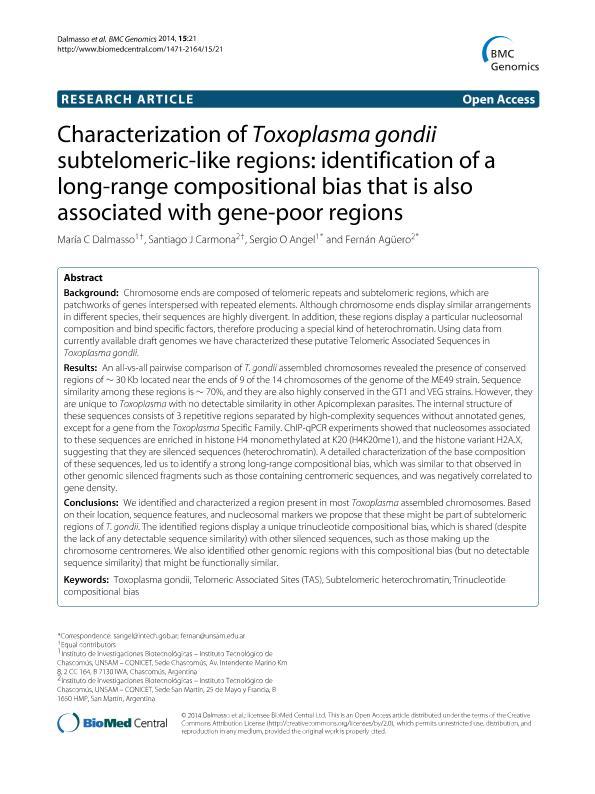Mostrar el registro sencillo del ítem
dc.contributor.author
Dalmasso, Maria Carolina

dc.contributor.author
Carmona, Santiago Javier

dc.contributor.author
Ángel, Sergio Oscar

dc.contributor.author
Agüero, Fernan Gonzalo

dc.date.available
2017-09-21T20:06:25Z
dc.date.issued
2014-01-13
dc.identifier.citation
Dalmasso, Maria Carolina; Carmona, Santiago Javier; Ángel, Sergio Oscar; Agüero, Fernan Gonzalo; Characterization of Toxoplasma gondii subtelomeric-like regions: identification of a long-range compositional bias that is also associated with gene-poor regions; BioMed Central; BMC Genomics; 15; 21; 13-1-2014; 21-36
dc.identifier.issn
1471-2164
dc.identifier.uri
http://hdl.handle.net/11336/24842
dc.description.abstract
Background Chromosome ends are composed of telomeric repeats and subtelomeric regions, which are patchworks of genes interspersed with repeated elements. Although chromosome ends display similar arrangements in different species, their sequences are highly divergent. In addition, these regions display a particular nucleosomal composition and bind specific factors, therefore producing a special kind of heterochromatin. Using data from currently available draft genomes we have characterized these putative Telomeric Associated Sequences in Toxoplasma gondii. Results An all-vs-all pairwise comparison of T. gondii assembled chromosomes revealed the presence of conserved regions of ∼ 30 Kb located near the ends of 9 of the 14 chromosomes of the genome of the ME49 strain. Sequence similarity among these regions is ∼ 70%, and they are also highly conserved in the GT1 and VEG strains. However, they are unique to Toxoplasma with no detectable similarity in other Apicomplexan parasites. The internal structure of these sequences consists of 3 repetitive regions separated by high-complexity sequences without annotated genes, except for a gene from the Toxoplasma Specific Family. ChIP-qPCR experiments showed that nucleosomes associated to these sequences are enriched in histone H4 monomethylated at K20 (H4K20me1), and the histone variant H2A.X, suggesting that they are silenced sequences (heterochromatin). A detailed characterization of the base composition of these sequences, led us to identify a strong long-range compositional bias, which was similar to that observed in other genomic silenced fragments such as those containing centromeric sequences, and was negatively correlated to gene density. Conclusions We identified and characterized a region present in most Toxoplasma assembled chromosomes. Based on their location, sequence features, and nucleosomal markers we propose that these might be part of subtelomeric regions of T. gondii. The identified regions display a unique trinucleotide compositional bias, which is shared (despite the lack of any detectable sequence similarity) with other silenced sequences, such as those making up the chromosome centromeres. We also identified other genomic regions with this compositional bias (but no detectable sequence similarity) that might be functionally similar.
dc.format
application/pdf
dc.language.iso
eng
dc.publisher
BioMed Central

dc.rights
info:eu-repo/semantics/openAccess
dc.rights.uri
https://creativecommons.org/licenses/by-nc-sa/2.5/ar/
dc.subject
Toxoplasma Gondii
dc.subject
Telomeric Associated Sites (Tas)
dc.subject
Subtelomeric Heterochromatin
dc.subject
Trinucleotide Compositional Bias
dc.subject.classification
Otras Ciencias de la Computación e Información

dc.subject.classification
Ciencias de la Computación e Información

dc.subject.classification
CIENCIAS NATURALES Y EXACTAS

dc.subject.classification
Bioquímica y Biología Molecular

dc.subject.classification
Ciencias Biológicas

dc.subject.classification
CIENCIAS NATURALES Y EXACTAS

dc.title
Characterization of Toxoplasma gondii subtelomeric-like regions: identification of a long-range compositional bias that is also associated with gene-poor regions
dc.type
info:eu-repo/semantics/article
dc.type
info:ar-repo/semantics/artículo
dc.type
info:eu-repo/semantics/publishedVersion
dc.date.updated
2017-09-18T14:31:19Z
dc.journal.volume
15
dc.journal.number
21
dc.journal.pagination
21-36
dc.journal.pais
Reino Unido

dc.journal.ciudad
Londres
dc.description.fil
Fil: Dalmasso, Maria Carolina. Consejo Nacional de Investigaciones Científicas y Técnicas. Centro Científico Tecnológico Conicet - La Plata. Instituto de Investigaciones Biotecnológicas. Instituto de Investigaciones Biotecnológicas "Dr. Raúl Alfonsín" (sede Chascomús). Universidad Nacional de San Martín. Instituto de Investigaciones Biotecnológicas. Instituto de Investigaciones Biotecnológicas "Dr. Raúl Alfonsín" (sede Chascomús); Argentina
dc.description.fil
Fil: Carmona, Santiago Javier. Consejo Nacional de Investigaciones Científicas y Técnicas. Centro Científico Tecnológico Conicet - La Plata. Instituto de Investigaciones Biotecnológicas. Instituto de Investigaciones Biotecnológicas "Dr. Raúl Alfonsín" (sede Chascomús). Universidad Nacional de San Martín. Instituto de Investigaciones Biotecnológicas. Instituto de Investigaciones Biotecnológicas "Dr. Raúl Alfonsín" (sede Chascomús); Argentina
dc.description.fil
Fil: Ángel, Sergio Oscar. Consejo Nacional de Investigaciones Científicas y Técnicas. Centro Científico Tecnológico Conicet - La Plata. Instituto de Investigaciones Biotecnológicas. Universidad Nacional de San Martín. Instituto de Investigaciones Biotecnológicas; Argentina
dc.description.fil
Fil: Agüero, Fernan Gonzalo. Consejo Nacional de Investigaciones Científicas y Técnicas. Centro Científico Tecnológico Conicet - La Plata. Instituto de Investigaciones Biotecnológicas. Universidad Nacional de San Martín. Instituto de Investigaciones Biotecnológicas; Argentina
dc.journal.title
BMC Genomics

dc.relation.alternativeid
info:eu-repo/semantics/altIdentifier/url/https://bmcgenomics.biomedcentral.com/articles/10.1186/1471-2164-15-21
dc.relation.alternativeid
info:eu-repo/semantics/altIdentifier/doi/http://dx.doi.org/10.1186/1471-2164-15-21
Archivos asociados
